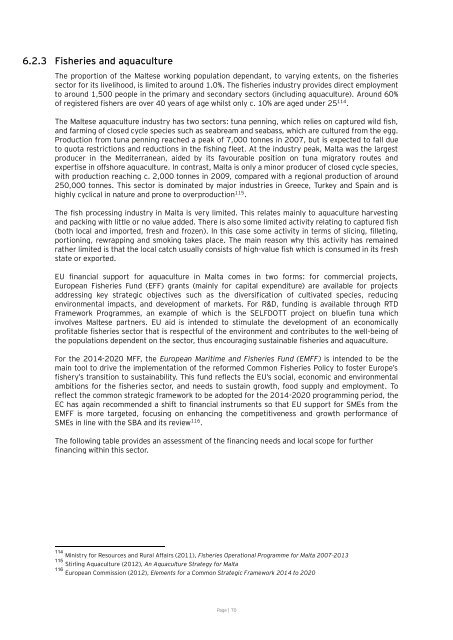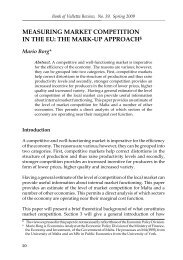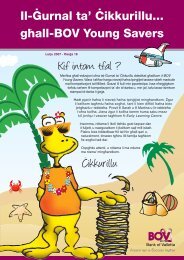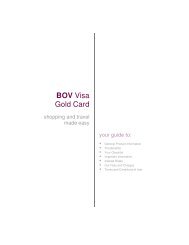Market Gaps on Access to Finance - Bank of Valletta
Market Gaps on Access to Finance - Bank of Valletta
Market Gaps on Access to Finance - Bank of Valletta
Create successful ePaper yourself
Turn your PDF publications into a flip-book with our unique Google optimized e-Paper software.
6.2.3 Fisheries and aquaculture<br />
The proporti<strong>on</strong> <strong>of</strong> the Maltese working populati<strong>on</strong> dependant, <strong>to</strong> varying extents, <strong>on</strong> the fisheries<br />
sec<strong>to</strong>r for its livelihood, is limited <strong>to</strong> around 1.0%. The fisheries industry provides direct employment<br />
<strong>to</strong> around 1,500 people in the primary and sec<strong>on</strong>dary sec<strong>to</strong>rs (including aquaculture). Around 60%<br />
<strong>of</strong> registered fishers are over 40 years <strong>of</strong> age whilst <strong>on</strong>ly c. 10% are aged under 25 114 .<br />
The Maltese aquaculture industry has two sec<strong>to</strong>rs: tuna penning, which relies <strong>on</strong> captured wild fish,<br />
and farming <strong>of</strong> closed cycle species such as seabream and seabass, which are cultured from the egg.<br />
Producti<strong>on</strong> from tuna penning reached a peak <strong>of</strong> 7,000 t<strong>on</strong>nes in 2007, but is expected <strong>to</strong> fall due<br />
<strong>to</strong> quota restricti<strong>on</strong>s and reducti<strong>on</strong>s in the fishing fleet. At the industry peak, Malta was the largest<br />
producer in the Mediterranean, aided by its favourable positi<strong>on</strong> <strong>on</strong> tuna migra<strong>to</strong>ry routes and<br />
expertise in <strong>of</strong>fshore aquaculture. In c<strong>on</strong>trast, Malta is <strong>on</strong>ly a minor producer <strong>of</strong> closed cycle species,<br />
with producti<strong>on</strong> reaching c. 2,000 t<strong>on</strong>nes in 2009, compared with a regi<strong>on</strong>al producti<strong>on</strong> <strong>of</strong> around<br />
250,000 t<strong>on</strong>nes. This sec<strong>to</strong>r is dominated by major industries in Greece, Turkey and Spain and is<br />
highly cyclical in nature and pr<strong>on</strong>e <strong>to</strong> overproducti<strong>on</strong> 115 .<br />
The fish processing industry in Malta is very limited. This relates mainly <strong>to</strong> aquaculture harvesting<br />
and packing with little or no value added. There is also some limited activity relating <strong>to</strong> captured fish<br />
(both local and imported, fresh and frozen). In this case some activity in terms <strong>of</strong> slicing, filleting,<br />
porti<strong>on</strong>ing, rewrapping and smoking takes place. The main reas<strong>on</strong> why this activity has remained<br />
rather limited is that the local catch usually c<strong>on</strong>sists <strong>of</strong> high-value fish which is c<strong>on</strong>sumed in its fresh<br />
state or exported.<br />
EU financial support for aquaculture in Malta comes in two forms: for commercial projects,<br />
European Fisheries Fund (EFF) grants (mainly for capital expenditure) are available for projects<br />
addressing key strategic objectives such as the diversificati<strong>on</strong> <strong>of</strong> cultivated species, reducing<br />
envir<strong>on</strong>mental impacts, and development <strong>of</strong> markets. For R&D, funding is available through RTD<br />
Framework Programmes, an example <strong>of</strong> which is the SELFDOTT project <strong>on</strong> bluefin tuna which<br />
involves Maltese partners. EU aid is intended <strong>to</strong> stimulate the development <strong>of</strong> an ec<strong>on</strong>omically<br />
pr<strong>of</strong>itable fisheries sec<strong>to</strong>r that is respectful <strong>of</strong> the envir<strong>on</strong>ment and c<strong>on</strong>tributes <strong>to</strong> the well-being <strong>of</strong><br />
the populati<strong>on</strong>s dependent <strong>on</strong> the sec<strong>to</strong>r, thus encouraging sustainable fisheries and aquaculture.<br />
For the 2014-2020 MFF, the European Maritime and Fisheries Fund (EMFF) is intended <strong>to</strong> be the<br />
main <strong>to</strong>ol <strong>to</strong> drive the implementati<strong>on</strong> <strong>of</strong> the reformed Comm<strong>on</strong> Fisheries Policy <strong>to</strong> foster Europe’s<br />
fishery’s transiti<strong>on</strong> <strong>to</strong> sustainability. This fund reflects the EU’s social, ec<strong>on</strong>omic and envir<strong>on</strong>mental<br />
ambiti<strong>on</strong>s for the fisheries sec<strong>to</strong>r, and needs <strong>to</strong> sustain growth, food supply and employment. To<br />
reflect the comm<strong>on</strong> strategic framework <strong>to</strong> be adopted for the 2014-2020 programming period, the<br />
EC has again recommended a shift <strong>to</strong> financial instruments so that EU support for SMEs from the<br />
EMFF is more targeted, focusing <strong>on</strong> enhancing the competitiveness and growth performance <strong>of</strong><br />
SMEs in line with the SBA and its review 116 .<br />
The following table provides an assessment <strong>of</strong> the financing needs and local scope for further<br />
financing within this sec<strong>to</strong>r.<br />
114 Ministry for Resources and Rural Affairs (2011), Fisheries Operati<strong>on</strong>al Programme for Malta 2007-2013<br />
115 Stirling Aquaculture (2012), An Aquaculture Strategy for Malta<br />
116 European Commissi<strong>on</strong> (2012), Elements for a Comm<strong>on</strong> Strategic Framework 2014 <strong>to</strong> 2020<br />
Page | 70







